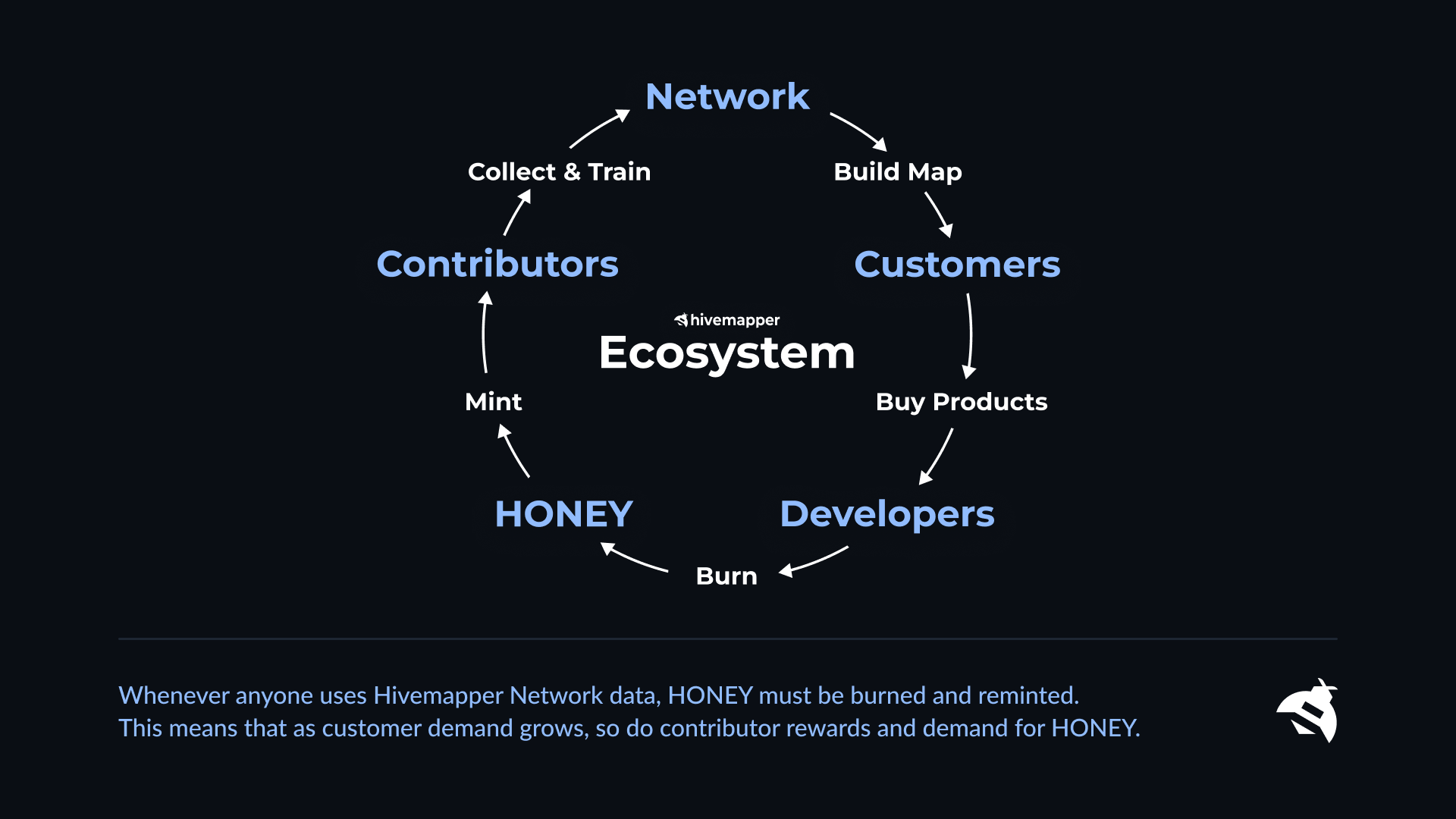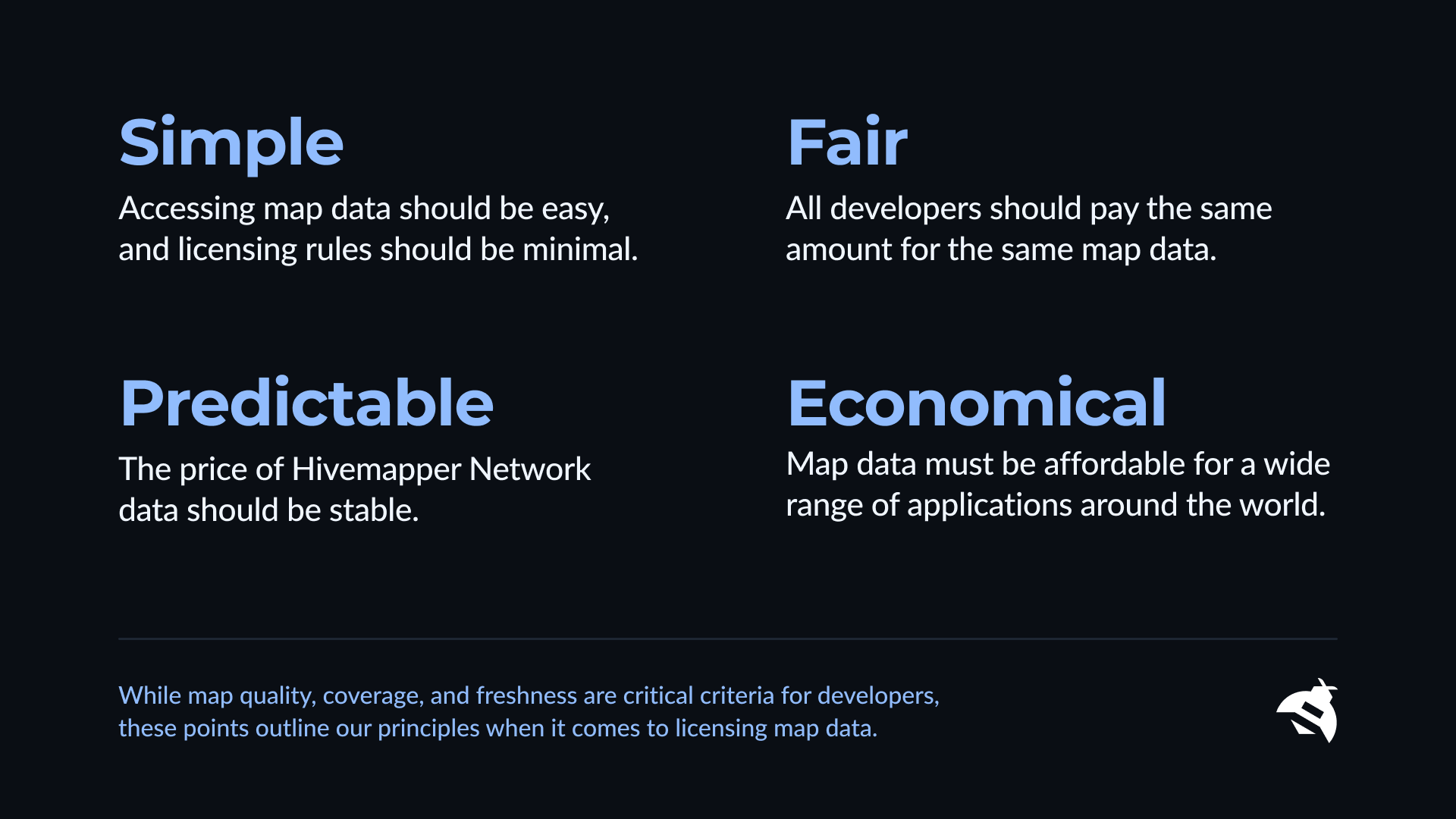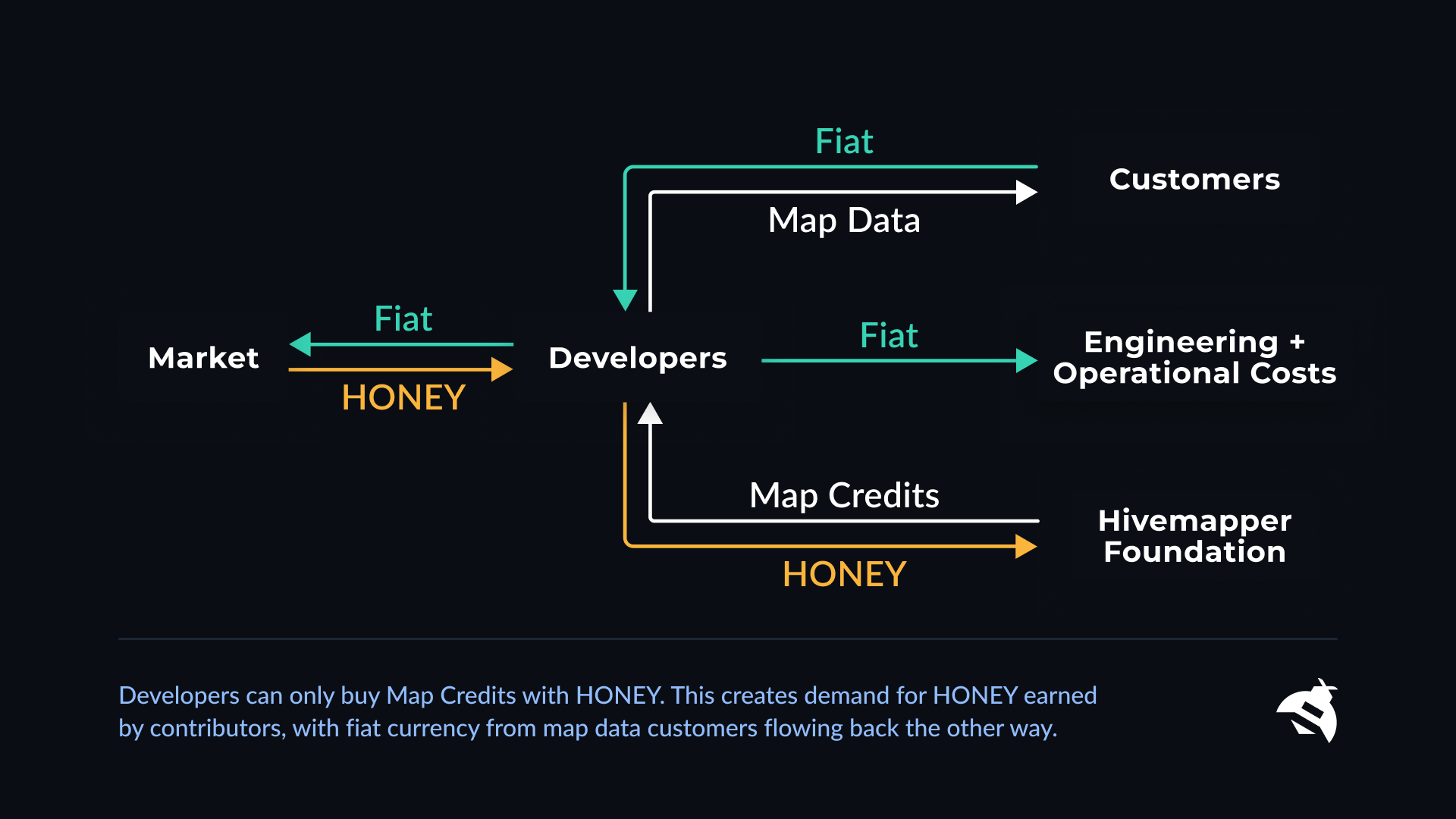

The design of HONEY uses a Burn and Mint structure to balance supply and demand on the Hivemapper Network, while serving the needs of two main groups of participants:
Under the Burn and Mint structure as modified in MIP-15, whenever HONEY is burned for map data usage, 75% is permanently burned and 25% is re-minted as Map Consumption Rewards for contributors up to a limit of 500,000 HONEY per week. As a result of this deflationary design, demand for Hivemapper Network data directly translates into added rewards for contributors while generating net demand for the HONEY tokens they hold.

Here's how it works. Any user of Hivemapper Network data must redeem Map Credits, which are non-transferable and can only be generated by burning HONEY. Map Credits have a fixed price of $0.005 USD, which ensures the price of map data will remain stable and predictable for end customers in USD terms.
For each protocol-level product, the Hivemapper Foundation is responsible for continually assessing the competitive landscape and establishing wholesale fees – the number of Map Credits a developer must spend to use a Hivemapper Network product.
As of October 2023, there are two core Hivemapper Network data products that can be consumed using Map Credits: Imagery and Map Features.
Imagery: A single Map Credit costing $0.005 worth of HONEY can be redeemed for one week of imagery from one map hex. The customer receives all images taken in the hex that week, whether it is one image or 100 images. With approximately 50 map hexes per kilometer, it costs approximately 50 Map Credits to consume one week’s imagery for 1 km of road. In fiat terms, this is $0.005 * 50, or $0.25 per kilometer per week.
Map Features: A single Map Credit costing $0.005 worth of HONEY can be redeemed for each individual Map Feature extracted from Hivemapper Network imagery and assigned to one map hex. The customer chooses the geographic area and pays one Map Credit for each hex within the area with one or more Map Features assigned to it. As an example, imagine a customer wanted the location and numerical value of all speed limit signs in an area. If the Hivemapper Network had a dataset of 1,000 speed limit signs in that area, each of which was located in a different hex, the customer would need 1,000 * $0.005 = $5 in Map Credits to consume the data. If the customer wanted three map features from each hex, they would need to pay $15 in Map Credits.
To understand how Map Credits maintain predictable pricing for developers and end users, consider this illustrative example. In these scenarios, a developer wants to consume one week’s worth of imagery for 20 km of roads. This requires approximately 1,000 Map Credits, worth $5 USD. The exact number of HONEY that must be burned to generate those Map Credits depends on the exchange rate between HONEY and USD, but the cost in USD never changes.
Scenario 1
Scenario 2
To conceptualize how developers and customers access map data, imagine the Hivemapper Network has designed an arcade game. To play the game once, a customer needs to put a token into a slot. The more tokens the customer has, the more times they can play the game.
In this analogy, Map Credits are arcade tokens issued by the Hivemapper Network, developers are the owners of arcades, and customers are the patrons of arcades.
Any developer accessing map data needs Map Credits. For imagery, the foundational product of the Hivemapper Network, each Map Credit buys one week of imagery from a single hex. These fees are non-negotiable, and the same for every developer.
Adopting a fixed, non-negotiable wholesale fee for each Hivemapper Network product creates a level playing field and encourages competition. This is because the raw materials of all Hivemapper Network products cost the same to every developer. The Hivemapper Foundation will provide fair and impartial support to any developer that seeks a license to access or help customers access Hivemapper Network data. If you are interested, please fill out this form.
It is important to remember that Map Credits are only one of the costs incurred by developers to build products using Hivemapper Network data. In practice, map customers need value-added services such as APIs for accessing data, integration into the customer’s data pipeline, custom image processing, and so on. Many of these services cause a licensed developer to incur additional costs beyond the Map Credits purchased to access Hivemapper Network data.
For this reason, although one Map Credit costs $0.005, licensed developers are free to set the price they charge to end customers to cover their costs and earn profit to sustain their business. This gives developers an incentive to develop value-added products and services. A broader array of products and services means more demand for Hivemapper Network data and for HONEY.

To understand this dynamic, let’s return to the arcade game analogy.
Not many people buy an arcade game for their home or business. Instead, most people choose to play arcade games at one of many establishments in their area.
Some clever entrepreneurs will offer other value-added services to attract people to their arcade, such as having animatronic animals do song-and-dance routines. Others will try innovative pricing models, such as a bundle that includes a slice of pizza and a drink along with game tokens. These value-added services cost money to provide. It would not be fair to ask these establishments to pay a share of their revenue for goods and services the Hivemapper Network did not provide. But no matter what each entrepreneur does, they all need to pay one token every time the arcade game is played, returning a fixed fee to the people who developed the game.
In conclusion, the fixed, non-negotiable wholesale price of Map Credits allows licensed developers to openly compete on a level playing field to serve map data customers. It gives developers an incentive to develop specialized value-added products – creating more ways for customers to gain value from Hivemapper Network data, and thus creating more demand for HONEY.
These examples describe three types of customers that developers will encounter, and how it influences the share of revenue they use to buy Hivemapper Network Map Credits. All three examples are for illustration only.
The first scenario describes a sophisticated customer that can consume imagery with little help. The second scenario describes a less sophisticated customer that needs help to consume imagery. And the third scenario describes a customer that buys value-added products built by licensed third-party developers using Hivemapper Network data, rather than buying raw imagery.
Example 1: Off-the-Shelf API Usage
A company called MapCo becomes a licensed developer, building tools for using Hivemapper Network data. MapCo incurs up-front technical development expenses, such as building an API to access Hivemapper Network data, and has ongoing sales, marketing and engineering expenses. When it goes to market, MapCo advertises a list price of $1 per km, and offers discounts for buying in bulk or paying upfront. A large logistics company signs a deal at a rate of $0.60 per kilometer after committing to pay upfront for 400,000 km of imagery, resulting in $240k in revenue for MapCo. The buyer is large and sophisticated, and does not need help ingesting the data. MapCo pays $100k in fiat to the Hivemapper Foundation for 20 million Map Credits – enough for the end customer to access 400,000 km of imagery. About 42% of revenue was used to buy HONEY. Some of the remaining revenue was used to cover costs, and some was profit for MapCo.
Example 2: Full-Service Integration
MapCo has now landed another customer: a roadway authority that wants fresh imagery of the roads it manages. However, the roadway authority is not particularly tech-savvy, and needs a custom internal tool to allow its road maintenance staff to access the data. The roadway authority agrees to pay upfront for 400,000 km of imagery at the same rate of $0.60 per kilometer, for a total of $240k. MapCo charges an additional flat fee of $50,000 to cover development costs for the internal tool. This adds up to $290k in revenue. Once again, MapCo pays $100k in fiat to the Hivemapper Foundation for 20 million Map Credits. The share of MapCo’s revenue used to buy Map Credits fell to 35% because value-added services were included in this deal, but the same amount of fees were paid because the same amount of map data was consumed.
Example 3: Value-Added Products
MapCo is growing. The company hires computer vision researchers from a local university, who have built a machine learning model that can estimate the size and depth of potholes. MapCo plans to use the model to extract valuable data from the Hivemapper Network. The roadway authority is eager to use the product, and agrees to pay $100,000 per month for a subscription to the map of potholes detected. To deliver this service, MapCo will need to consume 100,000 km of fresh Hivemapper Network imagery per month to update its map of potholes. To get those Map Credits, MapCo pays $25,000 in fiat to the Hivemapper Foundation each month, or about 25% of revenue. If other licensed developers come along with a similar product, the competition could result in lower prices for end customers, but all of these developers would need to pay the Hivemapper Network the fee of $0.005 per Map Credit.
HONEY must be exchanged for Map Credits to consume Hivemapper Network data. If a data user provides their own HONEY, the Hivemapper Foundation is obliged to return the equivalent amount of Map Credits based on the current exchange rate between HONEY and USD, with no upcharge beyond recovering the gas fee for the blockchain transaction.
However, many data users prefer to pay fiat rather than cryptocurrency.
For this reason, the Hivemapper Foundation plans to develop an automated service called the “Map Credit Machine.” It is expected to function such that if a customer provides fiat, the Map Credit Machine will automatically buy HONEY on the open market at the current exchange rate and return the equivalent amount of Map Credits minus a small transaction fee comparable to a credit card processing fee.
Until the launch of the automated Map Credit Machine, the Hivemapper Foundation plans to accept fiat from customers to pay for Map Credits, while charging a small transaction fee comparable to a credit card fee. When it accepts fiat, the Hivemapper Foundation will buy the equivalent amount of HONEY on the open market as soon as practicable and burn the HONEY to generate Map Credits.

Another restriction on Map Credit generation takes effect on Nov. 1, 2023: HONEY burned to generate Map Credits for paid use of map data may not come from a preminted project treasury.